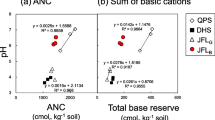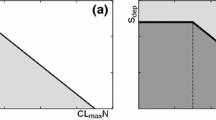Abstract
Critical loads of acidity were estimated for upland forests in Eastern Canada using the steady-state Simple Mass Balance (SMB) Model. A consistent methodology was applied to the entire region, although critical loads were estimated separately for the Atlantic provinces (New Brunswick, Nova Scotia, Prince Edward Island and Newfoundland), Quebec and Ontario using different data sources. In this project, critical load estimates and steady-state exceedance values did not include the effect of forest fire and forest harvesting, which could have a considerable impact on critical loads in Eastern Canada. The observed soil pH – base saturation relationship for forest soils indicated that the constants used into the calculation of alkalinity leaching should be set to 10 (M/M) for the molar Bc/Al ratio in soil leachate and 109 (mol L−1)2 for the gibbsite dissolution constant. The area-weighted median critical load for each province varied between 519 (Quebec) and 2063 eq ha−1 y−1 (Prince Edward Island), with a median critical load value for Eastern Canada of 559 eq ha−1 y−1. It is estimated that approximately 52% of the mapped area is exceeded in terms of acidity according to the 1994–1998 average total (wet + dry) atmospheric deposition. Greatest exceedances occurred in Ontario and Quebec and in the south of Nova Scotia, due to low critical loads and high loads of acid deposition.
Similar content being viewed by others
References
Akselsson, C., Ardo, J. and Sverdrup, H.: 2004, ‘Critical loads of acidity for forest soils and relationship to forest decline in the northern Czech Republic’, Environ. Monit. Assess. 98, 363–379.
Arp, P. A., Leger, W., Moayeri, M. H. and Hurley, J. E.: 2001, ‘Methods for mapping Forest Sensitivity to Acid Deposition for northeastern North America’, Ecosystem Health 7, 35–47.
Arp, P. A., Oja, T. and Marsh, M.: 1996, ‘Calculating critical S and N loads and current exceedances for upland forests in southern Ontario, Canada’, Can. J. For. Res. 26, 696–709.
Bélanger, N., Paré, D. and Yamasaki, S.: 2003, ‘The soil acid-base status of boreal black spruce stands after whole-tree and stem-only harvesting’, Can. J. For. Res. 33, 1874–1879.
Duchesne, L., Ouimet, R. and Houle, D.: 2002, ‘Basal area growth of Acer saccharum in relation to acid deposition, stand health and soil nutrients’. J. Env. Qual. 31, 1676–1683.
Dupont, J., Clair, T. A., Couture, S., Estabrook, R., Gagnon, C., Godfrey, P. J., Jeffries, D. S., Kahl, J. S., Khan, H., Nelson, S., Peckenham, J., Pilgrim, W., Stacey, P., Taylor, D. and Van Arsdale, A.: 2005, ‘Critical Loads of Acidity and Water Sensitivity in New England States and Eastern Canadian Provinces’, Environmental Monitoring Assessment (in press).
Environment Canada: 1993, ‘Canadian climate normals 1961–1990, Ontario’, National Climate Data and Information Archive, Meteorological Service of Canada, Environment Canada, Toronto, Ontario.
FPT MEE: 1998, ‘The Canada-wide acid rain strategy for post-2000. Strategy and supporting document’, Federal/Provincial/Territorial Ministers of Energy and Environment, Halifax, Nova Scotia, Canada, 11 pp.
Jeffries, D. S., Ouimet, R., Aherne, J., Arp, P. A., Balland, V., Demerchant, I., Dupont, J., Franklyn, J., Lam, D. C. L., Norouzian, F., Watmough, S. and Wong, I.: 2005, ‘Chapter 8.4. Critical load values and exceedances’, in Meteorological Service of Canada (ed.) 2004 Canadian acid deposition science assessment, Environment Canada, Ottawa, Canada, pp. 350–369.
MacDonald, K. B. and Valentine, K. W. G.: 1992, ‘CanSIS/NSDB. A general description’, Centre for Land and Biological Resources Research, Research Branch, Agriculture Canada, Ottawa., 40 pp.
Moayeri, M. H.: 2001, ‘Mass balance related to sustainability of forest biomass production: concepts and applications’, Ph.D. Thesis. University of New Brunswick, Fredericton, N. B., Canada, 291 pp.
Moayeri, M., Meng, F.-R., Arp, P. A. and Foster, N. W.: 2001, ‘Evaluating critical soil acidification loads and exceedances for a deciduous forest at the Turkey Lakes watershed’, Ecosystems 4, 555–567.
NEG/ECP Forest Mapping Group: 2001, ‘Protocol for assessment and mapping of forest sensitivity to atmospheric S and N deposition’. New England Governors and Eastern Canadian Premiers, Acid Rain Action Plan, Halifax, Canada.
Oja, T. and Arp, P. A.: 1998, ‘Critical loads of S and N’, in D. Maynard (ed.) Sulfur in the environment, Marcel Dekker, Inc., New York, pp. 337–364.
Ouimet, R., Camiré, C. and Furlan, V.: 1996, ‘Effect of base saturation of soil and endomycorrhization on growth and nutrient uptake of sugar maple seedlings’, Can. J. Soil Sci. 76, 109–115.
Ouimet, R., L. Duchesne, D. Houle, P. A. Arp.: 2001, ‘Critical loads of atmospheric S and N deposition and current exceedances for Northern temperate and boreal forests in Quebec’, Water Air Soil Pollut. Focus 1(1/2), 119–134.
Périé, C. and Ouimet, R.: 2003, ‘Le réseau d'étude et de surveillance des écosystémes forestiers québécois’, Direction de la recherche forestiére, Ministére des Ressources naturelles, de la Faune et des Parcs, Sainte-Foy (Québec), For. Res. Not. No. 122, 8 pp.
Posch, M., Hettelingh, J.-P. and Slootweg, J.: 2003, ‘Manual for dynamic modelling of soil response to atmospheric deposition’, RIVM Report 259101012/2003, Working Group on Effects of the CLRTAP, Bilthoven, The Netherlands, 71 pp.
Posch, M., de Smet, P. A. M., Hettelingh, J.-P. and Downing, R. J.: 2001, ‘Modelling and mapping of critical thresholds in Europe’, Working Group on Effects of the Convention on Long-range Transboundary Air Pollution, RIVM, Bilthoven, Netherlands, 188 pp.
Régniére, J.: 1996, ‘Generalized approach to landscape-wide seasonal forecasting with temperature-driven simulation models’, Environ. Entomol. 25, 869–881.
Ro, C. U. and Vet, R. J.: 2002, ‘Analyzed data fields from the National Atmospheric Chemistry Database (NAtChem) and Analysis Facility’, Air Quality Research Branch, Meteorological Service of Canada, Environment Canada, Toronto, Ontario.
Saucier, J.-P., Bergeron, J.-F., Grondin, P. and Robitaille, A.: 1998, ‘Les régions écologiques du Québec méridional (3e version) : un des éléments du systéme hiérarchique de classification écologique du territoire mis au point par le ministére des Ressources naturelles du Québec’, L'Aubelle (Suppl.) 124, 12 p.
Sverdrup, H., de Vries, W. and Henriksen, A.: 1990, ‘Mapping critical loads: a guidance to the criteria, calculations, data collection and mapping of critical loads’, Miljorapport (Environmental Report) 1990:14., Copenhagen: Nordic Council of Ministers. NORD: 1990:98, 124 p.
Thomsen, M. and Nellemann, C.: 2003, ‘Norway spruce mortality and critical air pollutant loads’, in D. F. Karnosky, K. E. Percy, A. H. Chappelka, C. Simpson and J. Pikkarainen (eds.), Air Pollution, Global Change and forests in the New Milleniu, Elsevier Science BV, New York, NY, pp. 289–299.
UBA: 2004, ‘UBA, 2004, Manual on methodologies and criteria for modelling and mapping critical loads and levels and air pollution effects risks, and trends’, UNECE Convention on Long-range Transboundary Air Pollution, Berlin, Germany, 202 pp.
Vet, R. J. and Shaw, M.: 2004, ‘1994–1998 average dry deposition velocities calculated using the MSC Air Quality Research Branch dry deposition model (RDM)’, Meteorological Service of Canada, Environment Canada, Toronto, Ontario.
Watmough, S. A. and Dillon, P. J.: 2003, ‘Do critical load models adequately protect forests? A case study in south-central Ontario’, Can. J. For. Res. 33, 1544–1556.
Author information
Authors and Affiliations
Corresponding author
Rights and permissions
About this article
Cite this article
Ouimet, R., Arp, P.A., Watmough, S.A. et al. Determination and Mapping Critical Loads of Acidity and Exceedances for Upland Forest Soils in Eastern Canada. Water Air Soil Pollut 172, 57–66 (2006). https://doi.org/10.1007/s11270-005-9050-5
Received:
Accepted:
Published:
Issue Date:
DOI: https://doi.org/10.1007/s11270-005-9050-5




